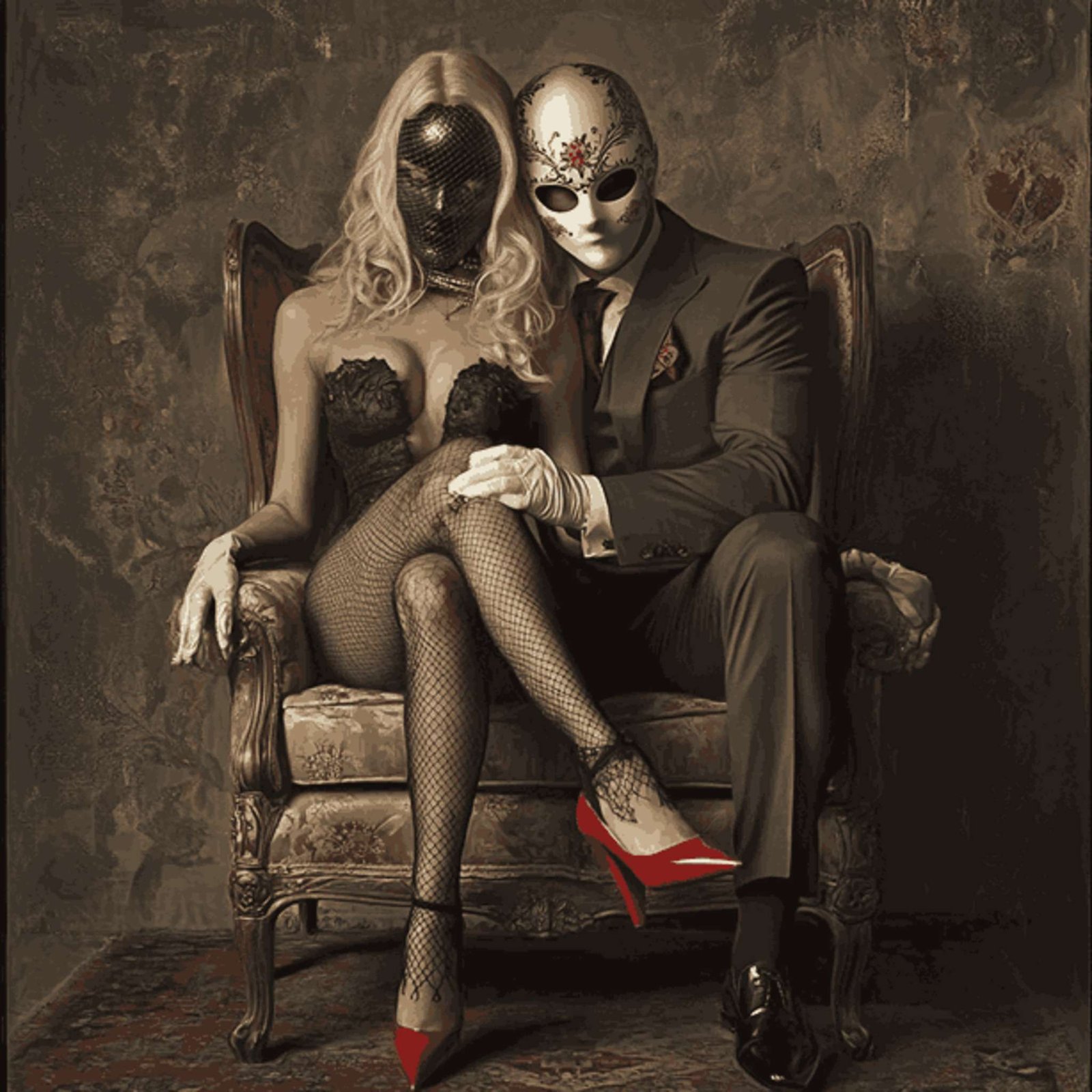Description
Exhibition Introduction and Art Critique: “Agnus Dei AZ9”
Stepping into Agnus Dei AZ9, we are drawn into a world where masks amplify roles in a drama of passion and dominance. These masks do more than conceal; they heighten our awareness of both visibility and secrecy, urging us to confront the essence of human desire and the dynamics of power that often unfold in intimate relationships.
The woman’s red shoes, a vibrant focal point, symbolize lust, danger, and control. Her pose radiates confidence—legs elegantly crossed and gaze hidden behind a delicate mask—indicating her mastery over the allure she exudes. The fishnet stockings enhance her sensuality, transforming garments into expressions of eroticism that invite rather than conceal.
Next to her, the man in black-tie attire captures our attention as well. His ornate, jewel-encrusted mask offers a striking contrast to her subtler façade. His posture, slightly inclined toward her, coupled with his hand resting on her thigh, conveys a sense of possession, yet also hints at a submissive undertone. This duality creates a tension central to the piece: are they partners in a mutual performance, or is one dominant over the other? This question lingers, prompting deeper contemplation of the power dynamics at play.
Influence, Meaning, and Message: The Mask as a Symbol of Desire and Control
At the core of Agnus Dei AZ9 lies the theme of the mask, a symbol that has long served as an object of ritual and performance. Here, masks embody both erotic play—evoking the secretive allure of masked balls—and metaphorical façades, representing the social roles we adopt to shield our vulnerabilities.
The title Agnus Dei, meaning “Lamb of God,” conjures connotations of sacrifice and purity, yet the visual elements—fishnets, tuxedos, and masks—transport us to a realm where desire and power reign. This contrast generates a rich dialogue about identity perception: are these characters the sacrificial lambs of a power game, or do they control their destinies, using their masks to transcend societal norms?
AZAD’s masks resonate with the work of erotic photography legends like Helmut Newton and Nobuyoshi Araki. Newton often portrayed powerful women in commanding poses, echoing the confident figure in Agnus Dei AZ9. The mask adds complexity to her allure—she is both inviting and distant, controlling and controlled.
Araki’s exploration of intimacy and shifting power dynamics similarly parallels the relationship between the figures in AZAD’s work. In Araki’s photography, submission is often ambiguous; a mutual consent exists, yet power dynamics are fluid. This ambivalence is mirrored in Agnus Dei AZ9, where the woman’s poised confidence and the man’s protective gesture suggest a complex balance of power, blending eroticism with theatricality.
Technique: Mixed Media and the Power of Visual Tension
AZAD’s technique in Agnus Dei AZ9 exemplifies his mastery of mixed media on canvas, merging digital precision with the tactile richness of traditional painting. The smooth surface contrasts with the depth of the figures and the luxurious texture of their clothing and the velvet chair, rendered with stunning realism. The digital manipulation of light and shadow enhances the chiaroscuro effect, focusing our attention on intricate details.
The 100 cm x 100 cm square format provides a sense of balance, yet AZAD introduces dynamic contrasts—vivid reds of her shoes against the opulent upholstery, the intricate lace of her mask juxtaposed with the darkness of his tuxedo. The positioning of the figures creates palpable intimacy, yet remains restrained, as if they are aware of an unseen audience.
This performative quality aligns Agnus Dei AZ9 with the traditions of erotic photography, where subjects navigate dual roles—both object and controller of the viewer’s gaze. In this artwork, the masks serve as tools of control, prompting engagement with body language, clothing, and power interplay rather than relying solely on facial expressions.
AZAD 777781: The Artist as Innovator and Storyteller
AZAD 777781 has emerged as a visionary digital artist, navigating the boundary between reality and the surreal. His exploration of human condition intricacies—fears, obsessions, and unspoken dynamics—fuels his distinctive figurative expressionism. In Agnus Dei AZ9, he captures not just surface appearances but the complex emotional and psychological landscapes underlying human behavior.
His international acclaim reflects his universal themes, offering a mirror for self-examination. Agnus Dei AZ9 invites us to confront our own masks and power dynamics, challenging us to recognize the roles we play in our lives.
A Poetic Expression of Greed, Passion, and Deep Philosophy
Agnus Dei AZ9 transcends its portrayal of two masked figures; it becomes a meditation on fundamental aspects of human experience—greed, passion, materialism, and the tension between appearance and reality. The visual richness—velvet chair, lace, tuxedo—suggests luxury, yet the masks hint at a deeper struggle for identity and connection.
The work critiques the performative nature of life within a materialistic society. The woman’s red shoes symbolize passion, while the man’s ornate mask suggests a façade of control that may mask more primal urges. Their luxurious setting evokes ritualistic undertones, framing them as participants in a dance of seduction or a battle for dominance—one defined by the masks they wear.
This tension between materialism and reality, surface and inner truth, recurs throughout AZAD’s oeuvre. He prompts us to evaluate the value of our masks: are they empowering tools, or do they trap us in unending roles? In Agnus Dei AZ9, the figures are simultaneously empowered and confined, their identities molded by the elaborate game of power and desire they embody.
Innovation and Imagination: AZAD’s Artistic Vision
AZAD pushes the boundaries of digital art while remaining connected to emotional and psychological realities. In Agnus Dei AZ9, he employs digital media to create a work that feels both timeless and modern, real and surreal.
His innovative approach to composition, lighting, and texture crafts a visual experience engaging on multiple levels. The richness of colors and precision of details contribute to a moment frozen in time—intimate yet distant, familiar yet enigmatic.
But beyond technical prowess, AZAD taps into deeper emotions and desires. In Agnus Dei AZ9, the masks, costumes, and luxurious surroundings serve as metaphors for navigating identity, power, and desire complexities. Through his art, AZAD urges us to look beyond surface appearances, delve into hidden depths, and question the roles we assume in the grand performance of life.
Conclusion: A Masterpiece of Tension, Desire, and Reflection
Agnus Dei AZ9 challenges us to confront our own masks—the roles we adopt, the desires we conceal, and the power dynamics shaping our relationships. Through mixed media, AZAD 777781 has crafted a visually stunning and intellectually provocative work that resonates on multiple levels.
As we engage with this artwork, we confront the complexities of human experience—the tension between appearance and reality, desire and restraint, and the intricate dance of power in our connections. Agnus Dei AZ9 stands as a testament to AZAD’s ability to encapsulate what it means to be human in an age defined by masks, façades, and hidden desires.





